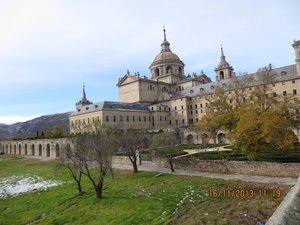Advertisement
Published: June 22nd 2017

 Monasterio de El Escorio
Monasterio de El Escorio
Remarkable condition for its 400+ age. Built by Phillip II using New World gold for his campaign to bolster the Catholic Church and resist the Protestant Reformation. The Inquisition was alive and well here and the library contains thousands of books and manuscripts confiscated by the Inquisition.Geo: 40.9494, -4.11921
Today a visit to two towns in the Sierra de Guadarrama, about 80km north west of Madrid.
El Escorial's main feature is a massive monastery/royal palace built by Phillip II in 1584. Nearly all Spanish monarchs from that time to the present are buried in the basilica, after their bodies spend 50 years in the Puridero (decaying place). We only looked at the outside, but the guide books indicate that many tourist treasures lie within.
About 10km from Escorial is the Valle de Los Caidos (Valley of the Fallen) basilica and monument, built in 1959 by Franco to commentate the 40,000 casualties of the Spanish Civil War who are buried there. The huge basilica (it's crypt is bigger than the one under St Peter's) is wholly excavated into a granite ridge and on the rocky outcrop summit is built a cross, 150m high and visible for miles. In 1975 Franco was buried in the church under a simple granite slab marked only "Francisco Franco", The back side of the hill contains the Benedictine monastery supporting the basilica.
Then onto Segovia, notable for its Aqueduct and the inspiration for Disney's fairy castle, Alcazar Segovia (Segovia Castle). It was cold, and we were delighted

 Garden of the Friars
Garden of the Friars
We were much impressed by the residual snow from the previous night's fall. Little did we know what was to come!to experience a minor snow storm lasting about an hour. Luckily we were inside an Italian restaurant, joking with the Sicilian staff and enjoying free grappa (used as a rinse in my espresso demi-tasse), limoncello and biscotti. Carol, we asked for granita and they were very pleased we knew of it.
See pics and captions (persevere with the download, lots of pics here).
Advertisement
Tot: 0.258s; Tpl: 0.011s; cc: 11; qc: 49; dbt: 0.0435s; 1; m:domysql w:travelblog (10.17.0.13); sld: 1;
; mem: 1.1mb

 Monasterio de El Escorio
Monasterio de El Escorio
 Garden of the Friars
Garden of the Friars















Rosie
non-member comment
Looks so cold - burrrrrrr........ You look like you are having a fantastic time.